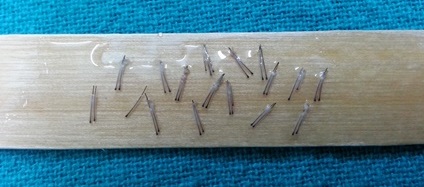Hair Transplant

Hair transplant is a procedure that involves transplanting individual hair follicles from donor site to bald area known as the 'recipient site'. The donor area commonly used is back of scalp as these follicles are resistant to the effect of DHT (Dihydrotestosterone). That's why this area is considered as permanent or safe hair bearing zone.
One should understand that hair transplant is the redistribution of the existing hair follicles in the donor area into the area of hair loss. Due to number of donor grafts being limited , they should be used wisely and judiciously keeping in mind the need for future also particularly if the patient is of young age group. Other areas from where follicles can be harvested are beard, upper chest, upper back, forearm, armpit, legs.
Modern hair transplant technique was started by Dr S. Okuda in Japan in the 1930's, who described the use of full thickness grafts of hair bearing skin.

The modern era of hair transplantation in the western world was ushered in the late 1950's, when New York dermatologist Norman Orentreich published his paper on hair transplant technique.
Hair Transplant Procedure:
Pre-operative assessment and planning:
At an initial discussion, the surgeon analyzes the patient's scalp, discusses their preferences and prospects, and advises them on the best approach. For several days prior to surgery the patients are refrained from using any kind of medicines for hair growth which might result in intra operative bleeding. Alcohol and smoking can contribute to poor graft survival, so patient is advised to stop smoking and taking alcohol before and for 2 weeks after procedure.
Surgery:
Hair transplant is performed on an outpatient basis, with mild sedation and under local anesthesia. The scalp is prepared by trimming the required areas if required and the applying the antiseptic agent.
There are different techniques for harvesting of hair follicles, each with their own advantages and disadvantages. Regardless of which donor harvesting technique is employed, proper extraction of the hair follicle is paramount to ensure the viability of the transplanted hair.
There are two main ways in which donor grafts are extracted:
a) Strip harvesting (FUHT).
b) Follicular unit extraction (FUE)
Strip Harvesting:
Strip harvesting is a well-known technique for removing hair follicles from a donor site. The surgeon harvests a strip of skin from the posterior scalp, the length and breadth of the strip is determined by the number of grafts required.The resultant wound is closed with primary suturing the wound using absorbable suture. The strip is then dissected into the individual follicular units with the help of microscope. Every precaution is taken not to damage the follicle while dissecting the strip. The recovery period is around 2 weeks and requires the stitches to be removed if required.
Follicular Unit Extraction:
With Follicular Unit Extraction or FUE harvesting, individual follicular units containing 1 to 4 hairs are extracted under local anesthesia. The surgeon then uses very small micro blades or fine needles to make the recipient site for the grafts, placing them in a predetermined density and pattern. The recipient sites are made keeping in mind the direction of the hairs so as to get a natural and realistic hair pattern. FUE gives very natural results. The advantage of FUE over strip harvesting is that FUE harvesting negates the need for large areas of scalp tissue to be harvested, so there is no linear cut on the back of the head and it doesn't leave a linear scar. The post-surgical pain and discomfort is minimum.
The recipient site creation and placement of grafts are same in both the techniques.
After hair transplant, there is generally a phase of shedding which starts at around 3-4 weeks and can go up to 12 weeks.
Lets have a quick idea about shedding after the procedure.
In this time the transplanted hairs undergo temporary shedding as during the surgery the follicles are extracted and placed in the recipient area. This temporarily compromise the blood supply to follicle which results in this phenomenon. In small number of patients, there may be no shedding at all.
The shedding is not limited to the transplanted hairs, the existing natural hairs may also undergo shedding for some months before the new hair grows. This may be due to the shock to the hairs rather than any permanent effect. As a result transplanted area may look less dense.
The newly transplanted hair begins to grow around 10-12 weeks after the procedure. There will be a visible growth in terms of length and density by around 6-7 months and it takes a maximum of one year for all the hairs to grow.
